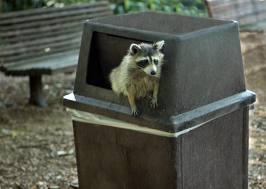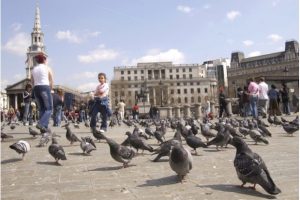Podcast: Play in new window | Download (Duration: 9:52 — 11.5MB)
Thanks to Wilmer and Carson for suggesting we revisit the dodo!
Further reading:
Dodos and spotted green pigeons are descendants of an island-hopping bird
On the possible vernacular name and origin of the extinct Spotted Green Pigeon Caloenus maculata
Giant, fruit-gulping pigeon eaten into extinction on Pacific islands
A taxidermied dodo:
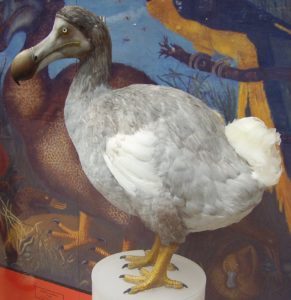
The Nicobar pigeon, happily still alive [photo by Devin Morris – Own work, CC BY-SA 4.0, https://commons.wikimedia.org/w/index.php?curid=110541928]:
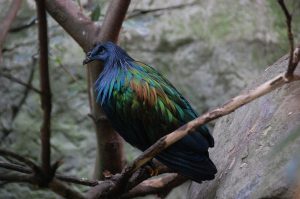
The 1823 illustration of the spotted green pigeon:
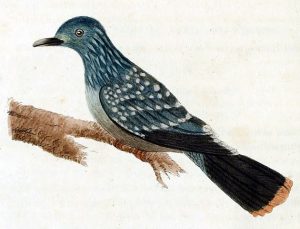
Show transcript:
Welcome to Strange Animals Podcast. I’m your host, Kate Shaw.
This week we’re going to revisit a bird that everyone’s heard of but no one has seen alive, because it’s famously extinct. We talked about the dodo way back in episode 19, so it’s definitely time we talked about it again. Thanks to Wilmer and Carson for suggesting it! We’re also going to learn about some of the close relations of the dodo.
The first report of a dodo was in 1598 by Dutch sailors who stopped by the island of Mauritius in the Indian Ocean. Mauritius is east of Madagascar, which is off the eastern coast of Africa. The last known sighting of a dodo was in 1662, just 64 years later. The dodo went extinct so quickly, and was so little known, that for a couple of centuries afterwards many people assumed it was just a sailor’s story. But there were remains of dodos, and in the 19th century scientists gathered up everything they could find to study the birds. More remains were found on Mauritius.
In the wild, the dodo was a sleek bird that could run quite fast. It may have eaten crabs and other small animals as well as roots, nuts, seeds, and fruit. It was also probably pretty smart. People only thought it was dumb because it didn’t run away from sailors—but it had no predators on Mauritius so never had to worry about anything more dangerous than an occasional egg-stealing crab before.
When humans arrived on Mauritius, they killed and ate dodos and their eggs. What the sailors didn’t eat, the animals they brought with them did, like pigs and rats. It was a stark and clear picture of human-caused extinction, shocking to the Victorian naturalists who studied it.
A lot of the drawings and paintings we have of dodos were made from badly taxidermied birds or from overfed captive birds. At least eleven live dodos were brought to Europe and Asia, some bound for menageries, some intended as pets. The last known captive dodo was sent to Japan in 1647.
The dodo grew over three feet tall, or almost a meter, with brown or gray feathers, a floofy tuft of gray feathers as a tail, big yellow feet, and a weird head. The feathers stopped around the forehead, making it look sort of like it was wearing a hood. Its face was bare and the bill was large, bulbous at the end with a hook, and was black, yellow, and green. The dodo looks, in fact, a lot like what you might expect pigeons to evolve into if pigeons lived on an island with no predators, and that’s exactly what happened.
The dodo’s closest living relation is the Nicobar pigeon, which can grow 16 inches long, or over 40 cm. Like other pigeons, the dodo’s feathers probably had at least some iridescence, but the Nicobar pigeon is extra colorful. Its head is gray with long feathers around its shoulders like a fancy collar, and the rest of its body is metallic blue, green, and bronze with a short white tail. Zoos love to have these pigeons on display because they’re so pretty. It’s a protected animal, but unfortunately it’s still captured for sale on the pet black market or just hunted for food. It only lays one egg a year so it doesn’t reproduce very quickly, and all this combined with habitat loss make it an increasingly threatened bird. Scientists are trying to learn more about it so it can be better protected.
The Nicobar pigeon lives on a number of islands in the South Pacific and it can fly. Sometimes an errant individual is discovered in Australia, often after storms. Imagine going into your back yard one day and seeing a 40-centimeter-long bird whose feathers shine like jewels! The Nicobar pigeon lives in small flocks and eats seeds, fruit, and other plant material.
An even closer relative to the dodo is also the most mysterious. We don’t even know for sure if it’s extinct, although that’s very likely. It’s the spotted green pigeon and we only have one specimen–and we don’t even know where it was collected, just that it was an island somewhere in the South Pacific. There used to be two specimens, but no one knows what happened to the second one.
For a long time researchers weren’t even sure the spotted green pigeon was a distinct species or just a Nicobar pigeon with weird-colored feathers, but in 2014, DNA testing on two of the remaining specimen’s feathers showed it was indeed a separate species. Researchers think the spotted green pigeon, the dodo, and another extinct bird, the Rodrigues solitaire, all descended from an unknown pigeon ancestor that liked to island hop. Sometimes some of those pigeons would decide they liked a particular island and would stay, ultimately evolving into birds more suited to the habitat.
The specimen we have of the spotted green pigeon is 13 inches long, or 32 cm. Its feathers are dark brown with green iridescence and it has long neck feathers like the Nicobar pigeon. It also has little yellowish spots on its wings and a yellow tip to its bill. Researchers think it was probably a fruit-eating bird that lived in treetops.
The only reason we know there were once two specimens of this mystery bird is from a book about birds published in 1783, where the author mentions having seen two specimens. There was also an 1823 book about birds with an illustration of the spotted green pigeon that differs from the known specimen in some details. Researchers think the illustration might have been painted from the now-missing specimen.
There’s more to this mystery, though, because in 2020 an ornithologist studied a 1928 book about Tahiti that mentioned a bird that sounds a lot like the spotted green pigeon. It was even called a pigeon in the book. Since the author of that book had drawn on studies made by her grandfather almost a hundred years before, and since her grandfather had interviewed Tahitians about their history and traditions and they told him about the pigeon, the ornithologist suggested the spotted green pigeon might actually be from Tahiti. Now that scientists have a clue about where to start looking for remains of the bird, we might learn more about it soon.
Also in 2020, a study was published about another pigeon from the Pacific Islands. Fossils of it were found on the island of Tonga, and the scientists determined that the bird probably went extinct soon after humans first arrived on the island 2,850 years ago. The pigeon has been named Tongoenas burleyi. It grew about 20 inches long, or 50 cm, not counting its tail. It could fly and probably spent a lot of its time in trees, eating fruit. There are lots of different trees on the island that produce really big fruit, some of it as big as a tennis ball. Scientists think the pigeon was adapted to swallow these huge fruits whole, digest them, and poop out the seeds. The trees still exist but they’re in decline and scientists think it may be because no birds remain on the island that can spread their seeds effectively.
We don’t have any feathers from the newly described pigeon, but it was probably colorful. We do have a lot of bones, because many charred bones have been discovered in cooking pits excavated by archaeologists.
We don’t know yet how or if Tongoenas is related to the dodo. The Pacific islands are home to at least 90 living species of pigeon, and many of them we don’t know much about. There are undoubtedly many more waiting to be discovered by scientists, whether living or extinct.
You can find Strange Animals Podcast at strangeanimalspodcast.blubrry.net. That’s blueberry without any E’s. If you have questions, comments, or suggestions for future episodes, email us at strangeanimalspodcast@gmail.com. We also have a Patreon at patreon.com/strangeanimalspodcast if you’d like to support us for as little as one dollar a month and get monthly bonus episodes.
Thanks for listening!

